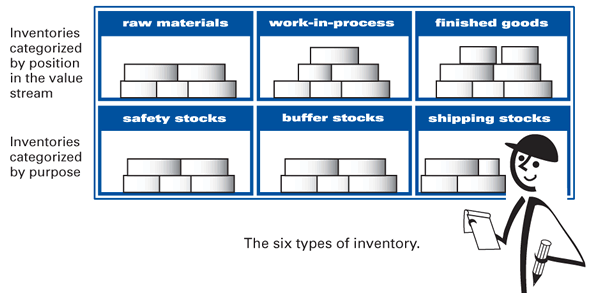Inventory
Materials (and information) present along a value stream between processing steps.
Physical inventories usually are categorized by position in the value stream and by purpose. Raw materials, work-in process, and finished goods are terms used to describe the position of the inventory within the production process. Buffer stocks, safety stocks, and shipping stocks are terms used to describe the purpose of the inventory. Since inventory always has both a position and a purpose (and some inventories have more than one purpose) the same items may be, for example, finished goods and buffer stocks. Similarly, the same items may be raw materials and safety stocks. And some items even may be finished goods, buffer stocks, and safety stocks (particularly if the value stream between raw materials and finished goods is short).
The size of the buffer and safety inventory levels will depend on the amplitude of the variations in downstream demand (creating the need for buffer stock) and the capability of the upstream process (creating the need for safety stock). Good lean practice is to determine the inventory for a process and to continually reduce it when possible, but only after reducing downstream variability and increasing upstream capability. Lowering inventory without addressing variability or capability will only disappoint the customer as the process fails to deliver needed products on time.
To avoid confusion, it is important to define each type of inventory carefully.
Buffer Stock
Goods held, usually at the downstream end of a facility or process, to protect the customer from starvation in the event of an abrupt increase in short-term demand that exceeds short-term production capacity.
The terms buffer and safety stock often are used interchangeably, which creates confusion. There is an important difference between the two, which can be summarized as: Buffer stock protects your customer from you (the producer) in the event of an abrupt demand change; safety stock protects you from incapability in your upstream processes and your suppliers.
Finished Goods
Items a facility has completed that await shipment.
Raw Materials
Goods in a facility that have not yet been processed.
Safety Stock
Goods held at any point (raw materials, WIP, or finished goods) to prevent downstream customers from being starved by upstream process capability issues. Also called emergency stock.
Shipping Stock
Goods in shipping lanes at the downstream end of a facility that are being built up for the next shipment. (These generally are proportional to shipping batch sizes and frequencies.) Also called cycle stock.
Work-in-Process (WIP)
Items between processing steps within a facility. In lean systems, standardized work-in-process is the minimum number of parts (including units in machines) needed to keep a cell or process flowing smoothly.
